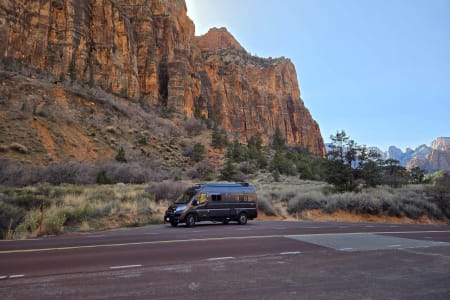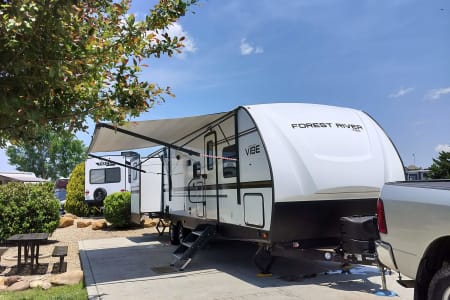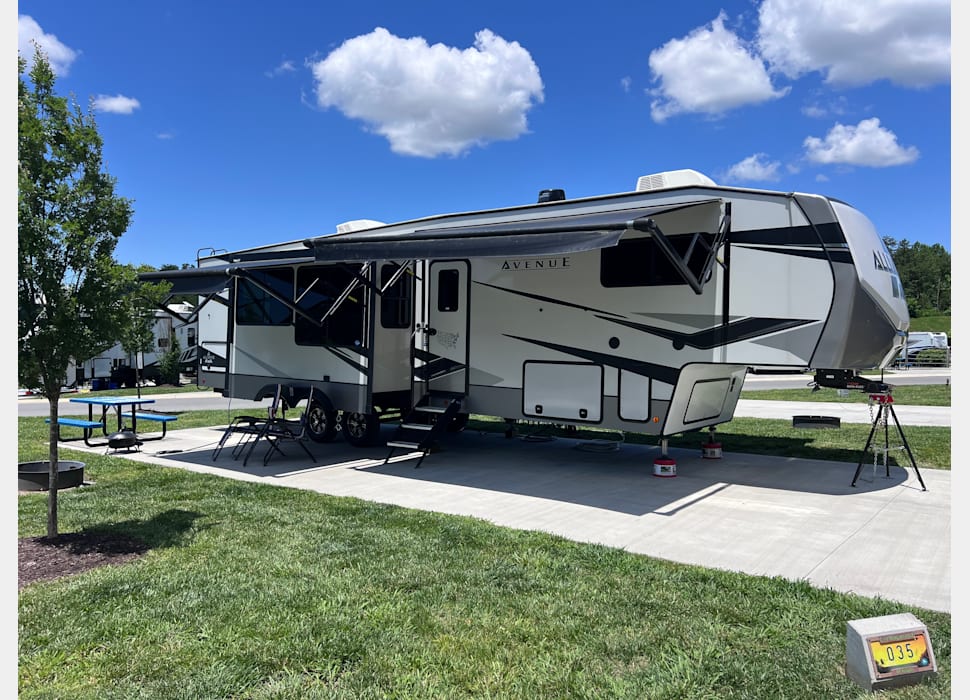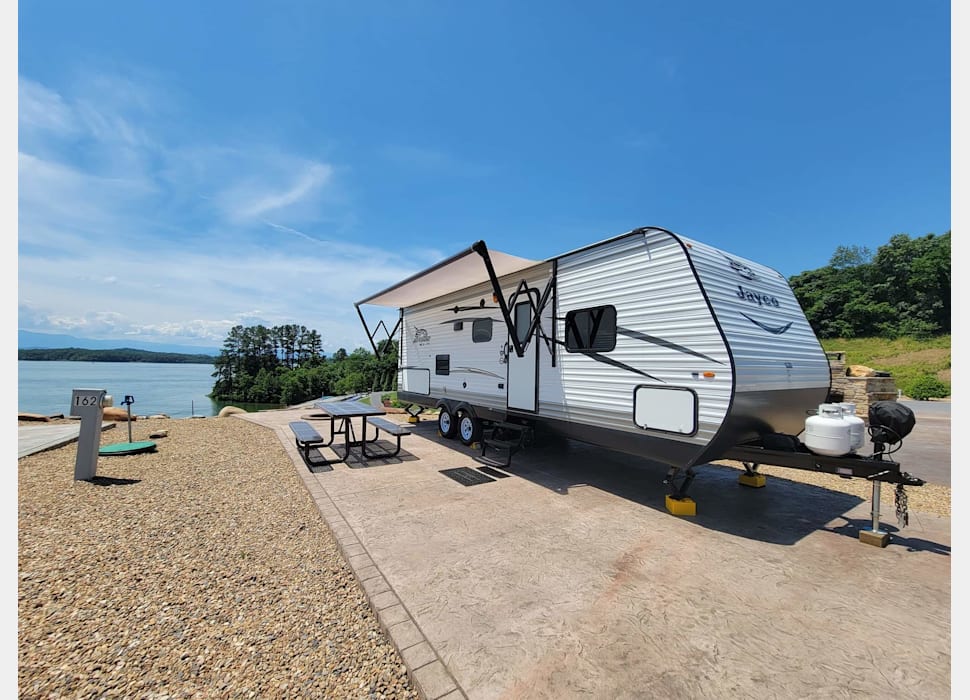Great Smoky Mountains National Park Tennessee (TN) RV Rentals
RV Rentals Dates
RV Rentals near Great Smoky Mountains National Park?
Introduction
Great Smoky Mountains National Park is a haven for RV camping enthusiasts, offering a unique blend of natural beauty, rich history, and a wide range of recreational activities. From its fascinating history and cultural significance to its breathtaking landscapes and diverse wildlife, this park has something for everyone.
RV camping in Great Smoky Mountains National Park is a popular choice for many reasons. The park boasts several well-maintained campgrounds that offer a range of amenities, including electrical hookups, water, and dump stations. With the convenience of RV camping, visitors can easily explore the park’s many attractions and enjoy the stunning views right from their doorstep. Plus, waking up to the sounds of nature and the fresh mountain air is an experience like no other.
RVThereYet.com is an RV rental company, offering a diverse fleet of motorhomes, including Class A, Class B, and Class C Rentals, Travel, Trailers, and Motorhomes for unforgettable adventures in scenic RV parks and campsites in Great Smoky Mountains National Park. Ensure early reservations for camper rentals at Great Smoky Mountains National Park.
Transportation
-
Driving/Transportation
When visiting Great Smoky Mountains National Park, private vehicle travel is the most convenient option. Visitors can access the park from multiple entrances, including Gatlinburg, Tennessee, and Cherokee, North Carolina. Both entrances offer easy access to the park’s main attractions and scenic drives. However, it’s important to note that there are restrictions on rig sizes within the park. RVs and trailers longer than 35 feet are not recommended on some of the park’s narrow and winding roads. It’s advisable to check the park’s website for specific restrictions and plan your visit accordingly.
-
Parking area
Great Smoky Mountains National Park offers designated RV parking areas at several of its campgrounds. These parking areas are equipped with amenities such as electrical hookups water and dump stations. Overnight parking outside of designated campsites is not permitted. While camping with an RV in the park is a popular choice it is also recommended to explore the park using alternative transportation methods such as hiking or biking to fully immerse yourself in the park’s natural beauty and avoid any potential parking limitations.
-
Public Transportation
Great Smoky Mountains National Park does not have public transportation options such as shuttle buses. However there are walking paths and trails throughout the park that allow visitors to explore on foot. These paths range from easy strolls to challenging hikes providing a unique opportunity to experience the park’s natural wonders up close. It’s recommended to bring comfortable walking shoes and a trail map to make the most of your visit.
Top Campsites in Great Smoky Mountains National Park
-
Reservations camping
Cades Cove Campground
Located within Great Smoky Mountains National Park Cades Cove Campground is a highly sought-after camping destination. With 159 sites it offers a mix of tent and RV camping options. The campground is known for its picturesque views and abundant wildlife making it a favorite among nature enthusiasts. Amenities include restrooms drinking water and a camp store. The campground is open year-round and is pet-friendly allowing pets on leashes. RV and trailer sizes up to 35 feet are permitted.
Elkmont Campground
Situated just outside Great Smoky Mountains National Park Elkmont Campground is another popular choice for campers. It offers 220 sites including both tent and RV camping options. The campground is known for its proximity to hiking trails and scenic waterfalls. Amenities include restrooms drinking water and a camp store. Elkmont Campground is open from March to November and is pet-friendly. RV and trailer sizes up to 32 feet are permitted.
Smokemont Campground
Located in the heart of Great Smoky Mountains National Park Smokemont Campground is a tranquil retreat for nature lovers. With 142 sites it offers a mix of tent and RV camping options. The campground is known for its access to hiking trails and fishing opportunities in nearby streams. Amenities include restrooms drinking water and a camp store. Smokemont Campground is open year-round and is pet-friendly. RV and trailer sizes up to 40 feet are permitted.
Townsend/Great Smokies KOA
Situated in Townsend Tennessee just outside the park’s entrance Townsend/Great Smokies KOA is a popular choice for those seeking a comfortable camping experience. The campground offers a variety of RV sites with full hookups tent sites and camping cabins. Amenities include a swimming pool playground and a camp store. The campground is pet-friendly and open year-round. RV and trailer sizes up to 70 feet are permitted.
These top 4 campsites near Great Smoky Mountains National Park offer a range of amenities and activities to cater to different camping preferences. Whether you prefer a rustic camping experience within the park or a more comfortable stay just outside the park these campsites provide a perfect base for exploring the natural wonders of the area.
-
First-come first-served
Deep Creek Campground
Deep Creek Campground is a first-come-first-served campground located in Great Smoky Mountains National Park. It offers 92 campsites including both tent and RV camping options. The campground is open from April to October and can accommodate RVs and trailers up to 26 feet in length. Amenities include restrooms drinking water and access to hiking trails and waterfalls. Deep Creek Campground is pet-friendly allowing pets on leashes.
Cosby Campground
Cosby Campground is another first-come-first-served option within Great Smoky Mountains National Park. It offers 157 campsites including both tent and RV camping options. The campground is open from April to October and can accommodate RVs and trailers up to 25 feet in length. Amenities include restrooms drinking water and access to hiking trails. Cosby Campground is pet-friendly allowing pets on leashes.
Balsam Mountain Campground
Balsam Mountain Campground is a remote and secluded first-come-first-served campground in Great Smoky Mountains National Park. It offers 46 campsites including both tent and RV camping options. The campground is open from May to October and can accommodate RVs and trailers up to 30 feet in length. Amenities include restrooms drinking water and access to hiking trails. Balsam Mountain Campground is pet-friendly allowing pets on leashes.
These first-come-first-served campsites in Great Smoky Mountains National Park provide a more flexible camping experience for those who prefer spontaneity or have not made advanced reservations. It’s important to arrive early to secure a campsite especially during peak seasons. These campgrounds offer a range of accommodations and amenities allowing visitors to enjoy the beauty of the park while immersing themselves in nature.
-
Alternate camping
Private Campgrounds
If the campsites inside Great Smoky Mountains National Park are full there are several private campgrounds in the surrounding area that offer additional camping options. These campgrounds often provide a range of amenities including full hookups showers and recreational facilities. Some popular private campgrounds near the park include Twin Creek RV Resort and River Plantation RV Resort. These campgrounds offer a comfortable camping experience with easy access to the park and its attractions.
Backcountry Camping
For those looking for a more adventurous camping experience backcountry camping is an excellent option. Great Smoky Mountains National Park offers over 800 miles of trails and numerous backcountry campsites. A backcountry permit is required and campers must follow specific regulations to ensure minimal impact on the environment. Backcountry camping allows RV renters to explore remote areas of the park and immerse themselves in the wilderness.
National Forest Campgrounds
The surrounding national forests such as Cherokee National Forest and Nantahala National Forest offer additional camping opportunities for RV renters. These campgrounds provide a more rustic camping experience with fewer amenities than private campgrounds. However they often offer beautiful natural settings and a sense of seclusion. Some popular national forest campgrounds near Great Smoky Mountains National Park include Indian Boundary Campground and Cheoah Point Campground.
These alternative camping options near Great Smoky Mountains National Park provide RV renters with flexibility and additional choices if the campsites inside the park are full. Private campgrounds offer a comfortable camping experience with modern amenities while backcountry camping and national forest campgrounds provide opportunities for adventure and immersion in nature.
-
General activities
Hiking
Great Smoky Mountains National Park is a hiker’s paradise offering over 800 miles of trails to explore. From easy nature walks to challenging summit hikes there’s a trail for every skill level. Popular hiking destinations include the Alum Cave Trail which leads to stunning views and unique geological formations and the Appalachian Trail which passes through the park. Hikers can immerse themselves in the park’s diverse ecosystems witness cascading waterfalls and spot wildlife along the way.
Fishing
With over 2 900 miles of streams and rivers Great Smoky Mountains National Park is a haven for fishing enthusiasts. The park is home to a variety of fish species including trout and bass. Anglers can cast their lines in designated fishing areas and enjoy a peaceful day of fishing surrounded by breathtaking scenery. Popular fishing spots include Abrams Creek Little River and Deep Creek.
Cycling
Cycling enthusiasts can enjoy scenic rides along the park’s many paved and gravel roads. Cades Cove Loop Road is a popular cycling route offering a 11-mile loop with picturesque views of meadows historic buildings and wildlife. The Clingmans Dome Road although steep rewards cyclists with panoramic views from the highest point in the park. Cyclists can also explore the nearby Gatlinburg Trail a 3.9-mile round trip trail that allows bikes.
Wildlife Spotting
Great Smoky Mountains National Park is known for its rich biodiversity and abundant wildlife. RV campers can embark on wildlife spotting adventures and have the chance to encounter black bears white-tailed deer elk and a variety of bird species. Cades Cove and Cataloochee Valley are popular areas for wildlife viewing. Visitors are advised to keep a safe distance and observe wildlife from afar to ensure their safety.
Scenic Drives
RV campers can take advantage of the park’s scenic drives and enjoy breathtaking views from the comfort of their vehicles. The Newfound Gap Road is a must-visit offering panoramic vistas as it winds through the mountains. The Roaring Fork Motor Nature Trail is another scenic drive that showcases the park’s natural beauty with opportunities to see historic cabins waterfalls and wildlife.
These popular recreational activities in Great Smoky Mountains National Park attract outdoorsy RV campers seeking adventure natural beauty and a chance to immerse themselves in the park’s diverse ecosystems. Whether it’s hiking to scenic viewpoints casting a line in pristine streams cycling along picturesque roads spotting wildlife or enjoying a leisurely scenic drive there’s no shortage of outdoor activities to delight RV campers in this magnificent national park.
-
Alternative activities
Sightseeing
Great Smoky Mountains National Park offers breathtaking landscapes and scenic viewpoints that are perfect for sightseeing. Visitors can drive along the Newfound Gap Road or the Foothills Parkway and enjoy panoramic views of the mountains. Clingmans Dome the highest point in the park offers an observation tower with 360-degree views. Cades Cove is a popular destination for sightseeing with its picturesque valley historic buildings and abundant wildlife.
Nature Watching
For those who prefer a more relaxed outdoor experience nature watching is a great option. Great Smoky Mountains National Park is home to a diverse range of plant and animal species. Visitors can spot wildflowers in the spring colorful fall foliage and various bird species throughout the year. Popular areas for nature watching include the Cataloochee Valley where elk can often be seen and the Oconaluftee Visitor Center which offers a variety of wildlife viewing opportunities.
Scenic Photography
Great Smoky Mountains National Park is a photographer’s dream with countless opportunities for stunning photos. From misty mountain vistas to cascading waterfalls the park offers endless Instagram-worthy spots. Cades Cove with its historic buildings and pastoral landscapes is a favorite among photographers. Clingmans Dome and Newfound Gap also provide breathtaking backdrops for memorable photos.
Auto Touring
RV campers can enjoy the beauty of Great Smoky Mountains National Park through leisurely auto tours. The park offers several scenic drives such as the Roaring Fork Motor Nature Trail and the Little River Road. These drives allow visitors to experience the park’s natural beauty from the comfort of their vehicles. Along the way there are pull-offs and viewpoints where campers can stop and take in the scenery or snap some photos.
Visitor Centers and Museums
Great Smoky Mountains National Park has several visitor centers and museums that offer educational and interactive experiences. The Sugarlands Visitor Center provides information about the park’s natural and cultural history. The Mountain Farm Museum showcases historic log buildings and offers a glimpse into Appalachian life. These visitor centers are a great option for those who prefer to learn about the park’s history and natural resources.
These alternative recreational activities in Great Smoky Mountains National Park cater to RV campers who may not be interested in more physically demanding outdoor activities. Whether it’s sightseeing nature watching capturing stunning photographs enjoying scenic drives or exploring visitor centers and museums there are plenty of options for everyone to appreciate the beauty and tranquility of this remarkable national park.
Season-specific experiences in Great Smoky Mountains National Park
-
Spring activities
Wildflower Viewing
Spring brings a burst of color to Great Smoky Mountains National Park as wildflowers bloom in abundance. Visitors can explore the park’s various trails and witness a stunning display of vibrant blooms. The Cove Hardwood Nature Trail located in the Chimneys Picnic Area is a popular spot for wildflower viewing with a diverse array of species such as trilliums violets and lady’s slippers.
Historic Buildings
Great Smoky Mountains National Park is home to several well-preserved historic buildings that offer a glimpse into the region’s past. The Walker Sisters’ Cabin located in Little Greenbrier is a notable landmark. This 19th-century cabin belonged to the Walker sisters who lived off the land and preserved the traditional Appalachian way of life. Visitors can step back in time and learn about the history and heritage of the region.
Springtime Waterfalls
Spring is an ideal time to witness the park’s waterfalls in their full glory. As the snow melts and the rain increases the waterfalls come to life with cascading water. Abrams Falls one of the park’s most popular waterfalls is a must-visit during the spring. Located on the Abrams Falls Trail this 20-foot waterfall is surrounded by lush greenery and offers a picturesque setting for nature lovers.
Scenic Drives
Springtime is the perfect season to embark on scenic drives through Great Smoky Mountains National Park. The Roaring Fork Motor Nature Trail is a popular choice offering stunning views of spring foliage historic buildings and rushing streams. The Newfound Gap Road is another scenic drive that provides panoramic vistas of the surrounding mountains and valleys showcasing the park’s natural beauty.
Photography Opportunities
Springtime in Great Smoky Mountains National Park presents endless photography opportunities. From capturing the vibrant colors of blooming wildflowers to photographing the misty waterfalls there are countless picturesque scenes to capture. Cades Cove with its historic buildings and scenic landscapes offers a wealth of photography opportunities especially during the spring when the meadows come alive with wildflowers.
These recreational activities and landmarks in Great Smoky Mountains National Park during the spring season provide RV campers with a chance to immerse themselves in the beauty of nature explore the park’s rich history and capture stunning photographs. Whether it’s admiring the wildflowers visiting historic buildings witnessing the power of waterfalls embarking on scenic drives or capturing the essence of spring through photography there’s something for everyone to enjoy in this remarkable national park.
-
Summer activities
Swimming and Tubing
Summer is the perfect time to cool off in the park’s refreshing streams and rivers. Visitors can take a dip in the cool waters of Deep Creek or enjoy tubing down the Little River. The park offers designated swimming areas and tubing spots where families and friends can relax and enjoy the summer sun.
Camping
Summer is a popular season for camping in Great Smoky Mountains National Park. The park’s campgrounds offer a range of amenities including picnic areas fire rings and access to hiking trails. Whether you prefer tent camping or RV camping spending a summer night under the stars in the park is a memorable experience.
Wildlife Spotting
Summer brings an abundance of wildlife activity in the park. Visitors can spot black bears deer elk and a variety of bird species during this season. Cades Cove and Cataloochee Valley are popular areas for wildlife viewing. Early mornings and late evenings are the best times to observe animals in their natural habitat.
Scenic Hiking
Great Smoky Mountains National Park offers numerous hiking trails that are perfect for exploring during the summer. The Laurel Falls Trail is a popular choice leading to a picturesque waterfall. The Rainbow Falls Trail is another favorite offering a challenging but rewarding hike to a stunning 80-foot waterfall. Hikers can enjoy the shade of the forest and the beauty of the park’s lush greenery during the summer months.
Evening Programs and Campfire Talks
During the summer the park offers a variety of evening programs and campfire talks. These educational and entertaining events take place at various campgrounds and visitor centers. Visitors can learn about the park’s history wildlife and conservation efforts while enjoying the warmth of a campfire.
These summer recreational activities in Great Smoky Mountains National Park provide RV campers with opportunities to enjoy the outdoors cool off in the water spot wildlife explore scenic trails and learn more about the park’s natural and cultural heritage. Whether it’s swimming camping wildlife spotting hiking or attending evening programs there’s no shortage of summertime fun in this magnificent national park.
-
Fall activities
Fall Foliage Viewing
Great Smoky Mountains National Park is renowned for its stunning fall foliage. During the autumn months the park’s forests transform into a vibrant display of reds yellows and oranges. Visitors can take scenic drives along the Newfound Gap Road or the Blue Ridge Parkway to witness the breathtaking colors. Hiking trails such as the Alum Cave Trail and the Andrews Bald Trail offer opportunities to immerse oneself in the beauty of the fall foliage up close.
Wildlife Watching
Fall is an excellent time for wildlife watching in the park. As animals prepare for winter they become more active and visible. Visitors may spot black bears white-tailed deer and elk during this season. Cades Cove and Cataloochee Valley are popular areas for wildlife sightings. Early mornings and late afternoons are the best times to observe these majestic creatures in their natural habitat.
Scenic Photography
The fall colors make Great Smoky Mountains National Park a paradise for photographers. From capturing the vibrant foliage against the backdrop of majestic mountains to photographing reflections in tranquil streams there are endless opportunities for stunning autumn shots. Cades Cove with its picturesque landscapes and historic buildings offers a wealth of photography opportunities during the fall season.
Fall Festivals and Events
Fall is a festive time in the park with various events and festivals celebrating the season. The Oconaluftee Visitor Center hosts the Mountain Life Festival showcasing traditional Appalachian crafts and music. The Townsend Fall Festival just outside the park offers live music arts and crafts and delicious food. These events provide a chance to immerse oneself in the local culture and experience the charm of the fall season.
Scenic Drives
Fall is the perfect season for leisurely drives through Great Smoky Mountains National Park. The park’s scenic drives such as the Cades Cove Loop Road and the Roaring Fork Motor Nature Trail offer breathtaking views of the fall foliage. Visitors can take their time stop at overlooks and capture the beauty of the changing colors.
These fall recreational activities in Great Smoky Mountains National Park provide RV campers with opportunities to witness the stunning fall foliage spot wildlife capture beautiful photographs immerse themselves in local festivals and enjoy leisurely drives through the park. Whether it’s admiring the vibrant colors observing wildlife capturing the essence of fall through photography attending festive events or taking in the scenic views there’s something for everyone to enjoy in this enchanting national park during the autumn season.
-
Winter activities
Winter Hiking
Winter transforms Great Smoky Mountains National Park into a serene winter wonderland. While some trails may be closed or inaccessible during this season there are still opportunities for winter hiking. The Laurel Falls Trail and the Little River Trail are popular options for winter hikes offering beautiful views and peaceful surroundings. Hikers can enjoy the tranquility of the park and witness the unique beauty of snow-covered landscapes.
Scenic Drives
Winter is a great time for scenic drives through Great Smoky Mountains National Park. The Newfound Gap Road and the Foothills Parkway offer breathtaking winter vistas of snow-capped mountains and frost-covered trees. Visitors can take their time stop at overlooks and capture the serene beauty of the winter landscape.
Wildlife Spotting
Winter provides unique opportunities for wildlife spotting in the park. With the foliage gone animals are more visible against the snowy backdrop. Visitors may have the chance to spot elk deer and even black bears during this season. Cades Cove and Cataloochee Valley are popular areas for wildlife sightings in the winter.
Photography
Winter offers photographers a chance to capture the park’s landscapes in a different light. From snow-dusted mountaintops to icicle-covered waterfalls there are endless opportunities for stunning winter photographs. Cades Cove with its open meadows and historic buildings provides a picturesque setting for winter photography.
Snowshoeing
When snow blankets the park snowshoeing becomes a popular activity for outdoor enthusiasts. Trails such as the Sugarlands Valley Nature Trail and the Oconaluftee River Trail offer opportunities for snowshoeing adventures. Snowshoers can explore the park’s winter landscapes and enjoy the peace and solitude of the snowy trails.
These winter recreational activities in Great Smoky Mountains National Park provide RV campers with opportunities to enjoy the park’s serene winter beauty. Whether it’s winter hiking scenic drives wildlife spotting photography or snowshoeing there are plenty of ways to embrace the tranquility and unique experiences that winter brings to this remarkable national park.













